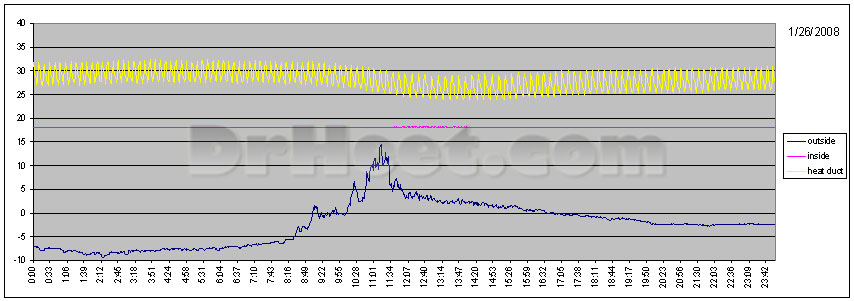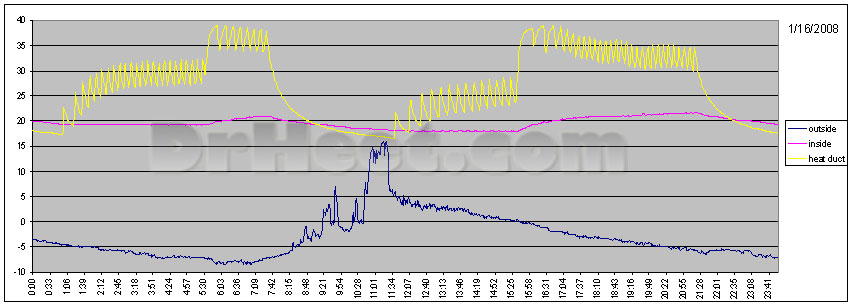How much money can I save by lowering the temperature of my thermostat when I am travelling
The answer depends, of course, on by how much the temperature is lowered. A number of things must be considered – plants or pets in the home, for instance, and even a fish tank may require a minimum temperature to prevent the fish from going belly-up. If you have nothing in the home that can get damaged by low temperatures, there is still the question of the plumbing, and the danger of frozen pipes. There is no rule of thumb, because every home is built differently. To be save, you should not go below 50°F.
Dr. Heet did a little bit of data analysis in an attempt to answer this question. This first chart below shows a normal week day when the owners were at work. The thermostat lowered the temperature to 64° from 7:30am through 3:30pm. The average outside temperature was 2.36°C that day. The furnace was on for 27% of the day.

The next chart shows a weekend day. The owners were away travelling and the thermostat was set to a constant 64°F (18°C) for the entire day. That day, the mean outside temperature was -2.35°C, almost 5°C (10°F) lower. Gas usage was about 5% higher with the furnace on for 32% of the day.

On a third day (1/16/2007) with the mean outside temperature similarly low at -2.9°C the owners were at work, but in the home in the evening and at night. The chart looks very similar to the one from 1/29.

If the charts are confusing, the following table should make it all clear.
|
Date |
Mean outside Temp |
Mean delta T |
% Furnace on |
|
|
at home/work |
2008.01.16 |
-2.91 |
22.5 |
27.7 |
|
away |
2008.01.26 |
-2.35 |
20.38 |
32.6 |
|
at home/work |
2008.01.29 |
2.36 |
17.26 |
27.2 |
Or does it? Surprisingly, the data do not show any savings from lowering the temperature to a constant level. It appears that the furnace runs the same amount of time with the same thermostat settings on two different days, even though the mean outside temperature differed by more than 5°C (10°F). On the other hand, lowering the temperature to one constant value cost 5% more energy, even on a mild day.
This result contradicts some of the other findings on this site (provided that the data are correct, which seems to be the case). How can this be explained? Dr. Heet is not sure, but one attempt of an explanation could be that by having different temperature levels during the day (at home vs. at school/work), the furnace remains off for hours while the home cools off, and these periods help with conserving energy more than the absolute outside temperature. Two days with substantial different outside temperatures only show a 5% difference in energy consumption. This means that raising the temperature in the home by a degree or two would have little effect on the energy bill.
Unfortunately, Dr. Heet does not have data for wind speed, cloud cover, and other factors that could have been contributors to these results. More data will have to be gathered and more days will have to be analyzed before a definitive answer will be available.



